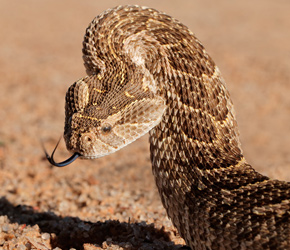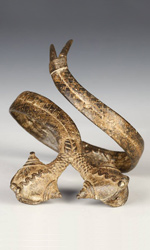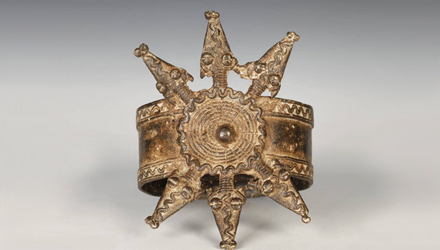 |
|
|
|
By Misaki Imagawa
In a small nameless village among the grasslands of southern Burkina Faso, farmers were already hard at work in the fields while the morning sun was still low in the sky. It was planting season; and every available hand was busy plowing the earth, sticking seeds in the ground, and working in unison on what everyone agreed was back breaking work. Even young children helped by chasing away pesky, seed-eating birds. Finally, when the sun rose in the sky and it was time to take a break, everyone gathered in the shade of a large Shea tree; and it was then they noticed the chief’s youngest son was missing. The farmers spread out, searching frantically through tall grass and unplowed fields. Eventually they found the boy sitting beside a bush, but their blood ran cold when they saw what was coiled around his legs. It was a venomous puff adder, resting its fat body across the boy’s lap!
 |
|
|
|
The villagers froze immediately to not arouse the snake, but it began to hiss loudly and puff its large body in warning. Every person there knew the danger. This snake could lunge and sink its long, poisonous fangs in the blink of an eye and kill a person before sunset. “You’ve angered him,” the boy muttered, unfazed by the snake’s threatening behavior. The chief, warning his son not to move, motioned for everyone else to slowly back away; and then he grasped a brass serpent band fitted over his upper arm. The son responded by touching a more petite version of the same band tied around his ankle. “He likes mine too,” he said. As if agreeing with the boy, the puffer calmed down and rested its small triangular head fondly against the boy’s band. Minutes later the snake slipped away and the boy stood and brushed himself off. The miraculous story quickly spread throughout the village and old traditions were stirred with renewed vigor and faith.
 |
|
|
|
Throughout many African countries, snakes have historically posed a great threat to humans. Lurking in the bush or under fallen logs, slithering unseen through the long grass, snakes have provided startling, instantaneous, and in many cases fatal experiences. Yet, despite the dangers of living among these animals, many tribes in Burkina Faso have seen snakes as sacred. Killing or eating them was forbidden, while the shedding of their skin was a symbol of rebirth. The animals were more than a symbol; to some they were mediators between this world and the next. In particular, the Lobi and Gan people incorporated the snake motif into much of their brass and copper artworks, which served as decoration, protective amulets and adornment, shrine ornaments, and metal currencies.
直到最近,从这个地区出现的大部分艺术都被认为是从洛杉矶那里出现,但市场上出现的日益异常的作品吸引了部落内的各种其他小组;特别是,甘人。虽然两个团体都创造了蛇艺术品,但每个人都有自己独特而独特的风格。Lobi经常穿着扁平的蛇货币换附器 - 平坦,起伏的金属蛇 - 捆绑在腿部的一侧,它们的形式有时出现在膝盖上滑动。随着Lobi主要是农民在田野里花了很多时间,碎片被佩戴,以提供对蛇的保护。一些蛇形式也被仪式目的创造,以纪念祭坛thil, the spirit of the land. Lobi serpents were usually crafted in iron and abstract in appearance.
 |
 |
||
|
|
|||
The Gan people also perceived the serpent as an entity possessing protective powers, featuring the creature in an array of metal works such as armbands, bracelets and amulets. Like the Lobi, they also used these forms as currency. However, their adornments were more life-like, stylized representations, although sometimes they appeared with multiple heads, arguably an abstract element. The Gan used these adornments as protectors of households against evil. Warriors also wore them for protection in battle. The snake’s great strength, speed and fearlessness made it a divine symbol for the Gan. They envisioned it coiling tightly around the earth to keep it from falling apart.
Is it belief that gives birth to stories or stories that inspire belief? The answer most likely is both. Every once in a while, tales of courageous moments fuse with traditional folklore, reinforcing and sometimes even reviving old beliefs. The story of the chief’s son epitomizes the snake as an animal to be feared as well as a sacred symbol and protector of the people. Whether it was the bands protecting the Chief and his son, or the snake’s respect for their fearlessness, this story illustrates the most dangerous foe can be the most powerful ally – especially among the tribal groups of West Africa.
 |
|
|
Download this blog:
 欢迎来到Burkina Fasssssso - 蛇形式货币(317 KB)
欢迎来到Burkina Fasssssso - 蛇形式货币(317 KB)
Among the Lobi and Gan people of Burkina Faso, snakes have long been venerated as protective entities and representations of divine powers. To honor the sacred animals, much of their metal currencies are shaped after serpents and are worn on the side of their legs or as armbands. The coiling, undulating figures remind us that fear and respect walk side-by-side.




